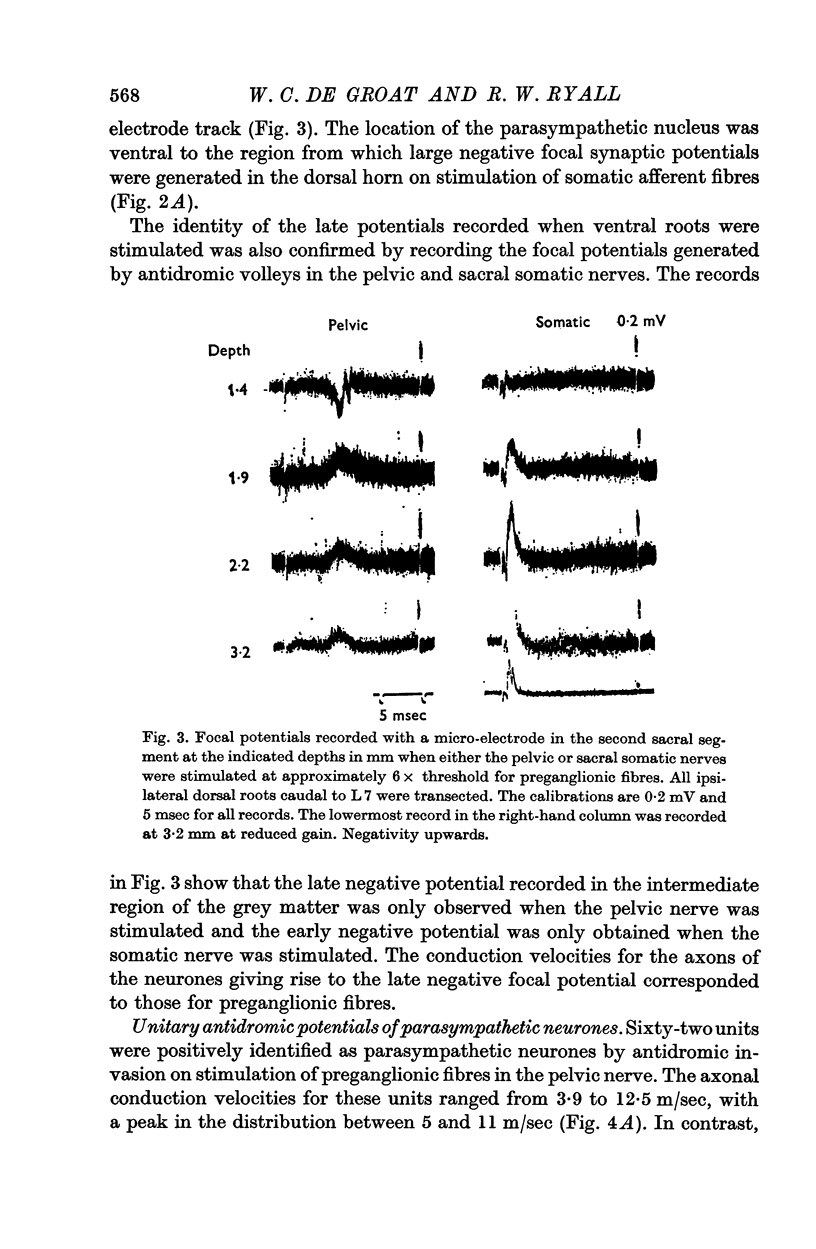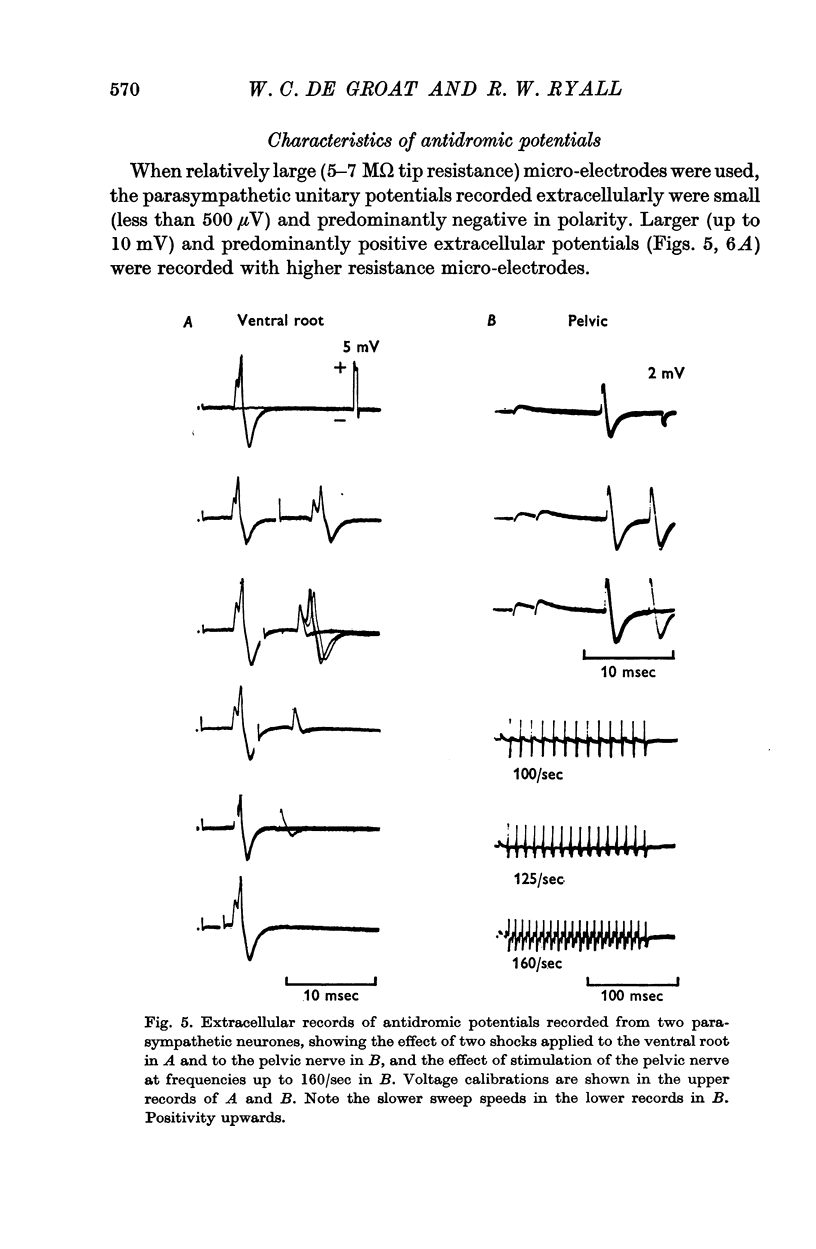Abstract
1. Sacral parasympathetic preganglionic neurones were identified by intracellular and extracellular micro-electrode recording of antidromic potentials in response to stimulation of the pelvic nerve or the second or third sacral ventral roots.
2. The segmental distribution of autonomic neurones varied in different cats. In some cats they were mainly in S2 segment, in others in S3 and in the remainder, in both S2 and S3.
3. The antidromic potentials showed initial segment-somadendritic (IS-SD) inflexions and delayed depolarizations and were slightly less prolonged than those of sympathetic neurones but more prolonged than those of spinal motoneurones. After-hyperpolarization was observed after the antidromic spike potential.
4. The conduction velocities for sacral parasympathetic preganglionic fibres were less than 12·5 m/sec and thus were similar to those of sympathetic preganglionic fibres.
5. Parasympathetic neurones were not excited by micro-electro-phoretically applied 5-hydroxytryptamine, noradrenaline or acetylcholine.
Full text
PDF














Selected References
These references are in PubMed. This may not be the complete list of references from this article.
- Appelberg B., Bessou P., Laporte Y. Action of static and dynamic fusimotor fibres on secondary endings of cat's spindles. J Physiol. 1966 Jul;185(1):160–171. doi: 10.1113/jphysiol.1966.sp007978. [DOI] [PMC free article] [PubMed] [Google Scholar]
- BROCK L. G., COOMBS J. S., ECCLES J. C. Intracellular recording from antidromically activated motoneurones. J Physiol. 1953 Dec 29;122(3):429–461. doi: 10.1113/jphysiol.1953.sp005013. [DOI] [PMC free article] [PubMed] [Google Scholar]
- COOMBS J. S., ECCLES J. C., FATT P. The electrical properties of the motoneurone membrane. J Physiol. 1955 Nov 28;130(2):291–325. doi: 10.1113/jphysiol.1955.sp005411. [DOI] [PMC free article] [PubMed] [Google Scholar]
- De Groat W. C., Ryall R. W. An excitatory action 0f 5-hydroxytryptamine on sympathetic preganglionic neurones. Exp Brain Res. 1967;3(4):299–305. doi: 10.1007/BF00237556. [DOI] [PubMed] [Google Scholar]
- ECCLES J. C., FATT P., KOKETSU K. Cholinergic and inhibitory synapses in a pathway from motor-axon collaterals to motoneurones. J Physiol. 1954 Dec 10;126(3):524–562. doi: 10.1113/jphysiol.1954.sp005226. [DOI] [PMC free article] [PubMed] [Google Scholar]
- Eccles J. C. The action potential of the superior cervical ganglion. J Physiol. 1935 Oct 26;85(2):179–206.2. doi: 10.1113/jphysiol.1935.sp003313. [DOI] [PMC free article] [PubMed] [Google Scholar]
- Elliott T. R. The innervation of the bladder and urethra. J Physiol. 1907 Jul 2;35(5-6):367–445. doi: 10.1113/jphysiol.1907.sp001198. [DOI] [PMC free article] [PubMed] [Google Scholar]
- FATT P. Electric potentials occurring around a neurone during its antidromic activation. J Neurophysiol. 1957 Jan;20(1):27–60. doi: 10.1152/jn.1957.20.1.27. [DOI] [PubMed] [Google Scholar]
- FRANK K., FUORTES M. G. Potentials recorded from the spinal cord with microelectrodes. J Physiol. 1955 Dec 29;130(3):625–654. doi: 10.1113/jphysiol.1955.sp005432. [DOI] [PMC free article] [PubMed] [Google Scholar]
- Fernandez de Molina A., Kuno M., Perl E. R. Antidromically evoked responses from sympathetic preganglionic neurones. J Physiol. 1965 Sep;180(2):321–335. doi: 10.1113/jphysiol.1965.sp007705. [DOI] [PMC free article] [PubMed] [Google Scholar]
- GRANIT R., KERNELL D., SMITH R. S. DELAYED DEPOLARIZATION AND THE REPETITIVE RESPONSE TO INTRACELLULAR STIMULATION OF MAMMALIAN MOTONEURONES. J Physiol. 1963 Oct;168:890–910. doi: 10.1113/jphysiol.1963.sp007229. [DOI] [PMC free article] [PubMed] [Google Scholar]
- IGGO A. The electrophysiological identification of single nerve fibres, with particular reference to the slowest-conducting vagal afferent fibres in the cat. J Physiol. 1958 Jun 18;142(1):110–126. doi: 10.1113/jphysiol.1958.sp006002. [DOI] [PMC free article] [PubMed] [Google Scholar]
- Langley J. N., Anderson H. K. The Innervation of the Pelvic and adjoining Viscera: Part VII. Anatomical Observations. J Physiol. 1896 Oct 19;20(4-5):372–406. doi: 10.1113/jphysiol.1896.sp000629. [DOI] [PMC free article] [PubMed] [Google Scholar]
- Nelson P. G., Burke R. E. Delayed depolarization in cat spinal motoneurons. Exp Neurol. 1967 Jan;17(1):16–26. doi: 10.1016/0014-4886(67)90118-5. [DOI] [PubMed] [Google Scholar]
- REXED B. A cytoarchitectonic atlas of the spinal cord in the cat. J Comp Neurol. 1954 Apr;100(2):297–379. doi: 10.1002/cne.901000205. [DOI] [PubMed] [Google Scholar]
- Widdicombe J. G. Action potentials in parasympathetic and sympathetic efferent fibres to the trachea and lungs of dogs and cats. J Physiol. 1966 Sep;186(1):56–88. doi: 10.1113/jphysiol.1966.sp008020. [DOI] [PMC free article] [PubMed] [Google Scholar]


